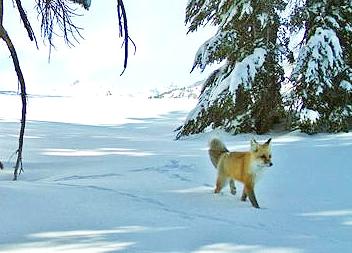
YOSEMITE NATIONAL PARK, California, January 29, 2015 (ENS) – Photos of the rare Sierra Nevada red fox, Vulpes vulpes necator, have been taken by motion-triggered cameras in Yosemite National Park, the first confirmed sighting of this species of fox in the park in nearly 100 years.
The Sierra Nevada red fox of California is one of the rarest mammals in North America, with fewer than 50 individuals surviving in the wild.
Yosemite Park wildlife biologists had gone on a five-day backcountry trip to the far northern part of the park to check on previously deployed motion-sensitive cameras.

They found images of the fox taken on two separate instances – December 13, 2014 and January 4, 2015.
“We are thrilled to hear about the sighting of the Sierra Nevada red fox, one of the most rare and elusive animals in the Sierra Nevada,” said Yosemite National Park Superintendent Don Neubacher.
“National parks like Yosemite provide habitat for all wildlife, and it is encouraging to see that the red fox was sighted in the park,” he said.
“Confirmation of the Sierra Nevada red fox in Yosemite National Park’s vast alpine wilderness provides an opportunity to join research partners in helping to protect this imperiled animal,” said Sarah Stock, wildlife biologist in Yosemite. “We’re excited to work across our boundary to join efforts with other researchers that will ultimately give these foxes the best chances for recovery.”
The nearest verified sightings of Sierra Nevada red foxes have been in the Sonora Pass area, north of the park, where biologists from the University of California, Davis, California Department of Fish and Wildlife, and U.S. Forest Service have been monitoring a small Sierra Nevada red fox population, first documented by the Forest Service in 2010.
Before 2010, the last verified sighting of a Sierra Nevada red fox in the region was 20 years ago.
Hoping to document more of the rare animals, the Yosemite carnivore crew will continue to survey for Sierra Nevada red fox using remote cameras.
At each camera station, the crew also set up hair snare stations to obtain hair samples for genetic analysis.
Through genetic analysis, the park can learn more about the diversity within the population and to confirm whether the fox or foxes detected in Yosemite are genetically related to those from the Sonora Pass area.
These Sierra Nevada red fox detections are part of a larger study funded by the Yosemite Conservancy to determine occurrence and distribution of rare carnivores in Yosemite National Park.
“Thank you to all our colleagues who have been helping us with this project in many important ways,” said Neubacher, naming the Central Sierra Environmental Resource Center, the U.S. Department of the Interior’s Bureau of Land Management, and Yosemite backcountry rangers and volunteers in addition to scientists from the University of California, Davis, California Department of Fish and Wildlife, and the U.S. Forest Service.
First protected in 1864, the 1,200 square miles of Yosemite National Park encompass a vast wilderness area with waterfalls, deep valleys, expansive meadows and ancient giant sequoia trees.
Yosemite National Park supports more than 400 species of vertebrates including fish, amphibians, reptiles, birds, and mammals. Wildlife species in the park include bobcat, gray fox, mountain kingsnake, Gilbert’s skink, white-headed woodpecker, brown creeper, spotted owl, and a wide variety of bat species. Above the treeline, species such as pika, yellow-bellied marmot, white-tailed hare, Clark’s nutcracker, and rosy finch are found. Sierra Nevada bighorn sheep live in the Yosemite area only around Tioga Pass, where a small, reintroduced population exists.
Copyright Environment News Service (ENS) 2015. All rights reserved.
© 2015, Environment News Service. All rights reserved. Content may be quoted only with proper attribution and a direct link to the original article. Full reproduction is prohibited.
